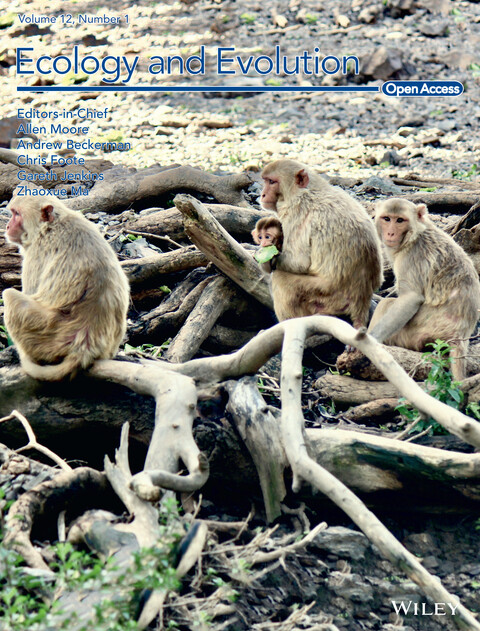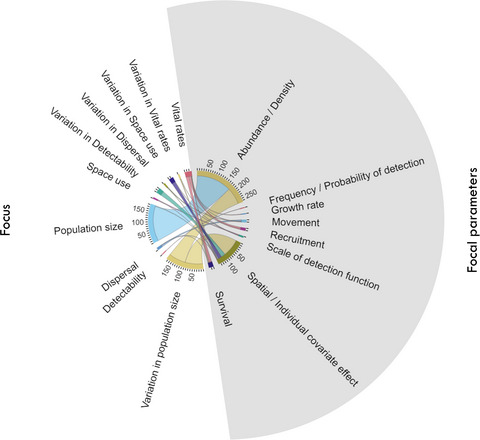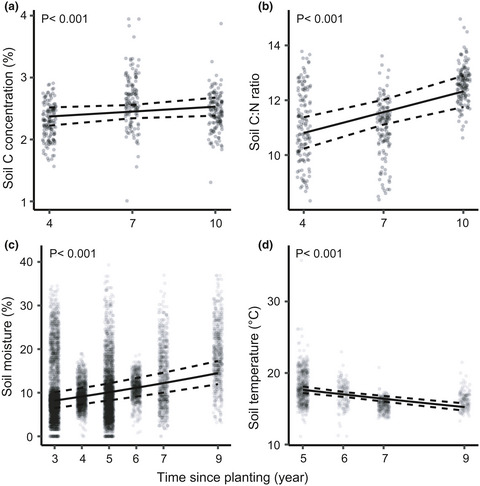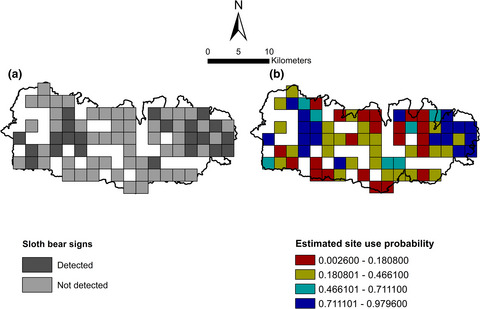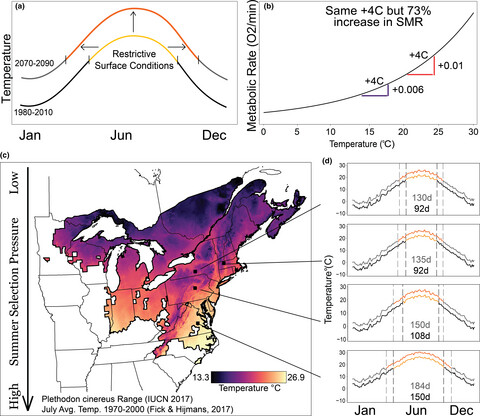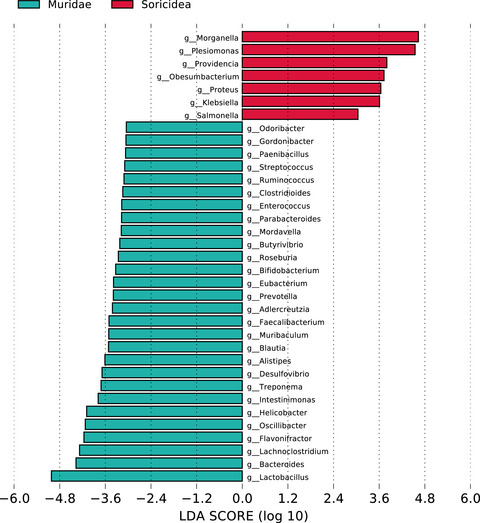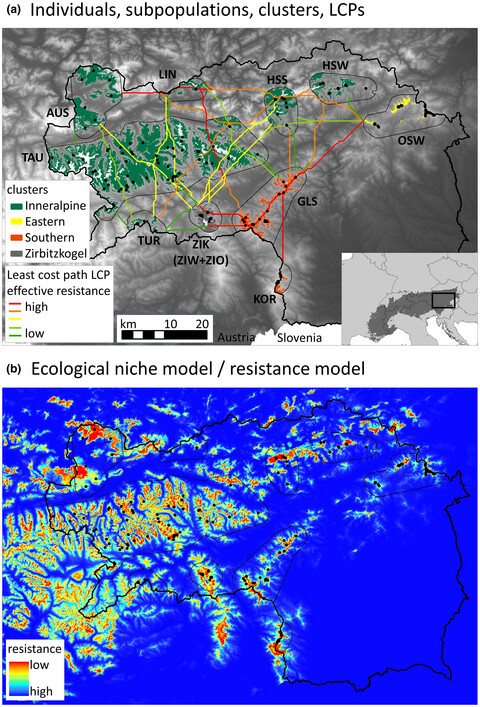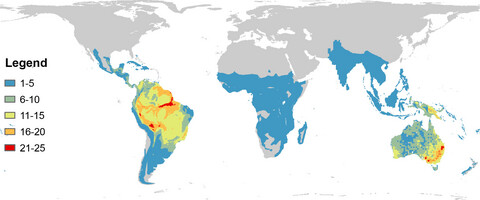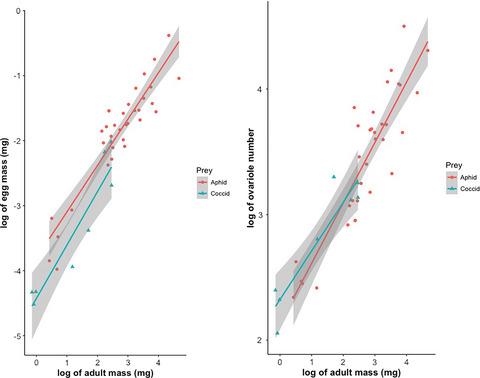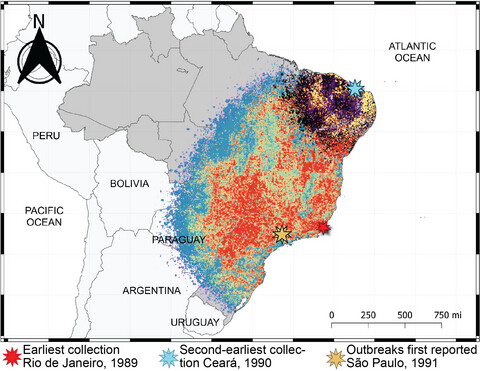Journal list menu
Export Citations
Download PDFs
ISSUE INFORMATION
NATURE NOTES
Incomplete recovery of seeds from scatterhoards by granivorous rodents: Implications for plant establishment
- First Published: 13 January 2022
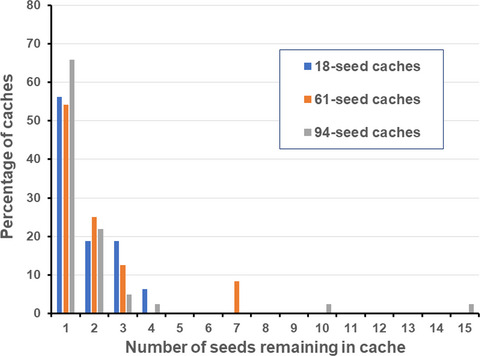
We documented the sloppiness of seed removal from scatterhoards of soapweed yucca (Yucca glauca) seeds by Ord's kangaroo rats (Dipodomys ordii). In two different experiments, we observed that >50% of caches removed or pilfered by kangaroo rats in the Sandhill Region of Nebraska had at least one seed remaining, with about 30% leaving limited seeds at the bottom of caches. Remaining seeds, especially those buried at bottoms of caches, likely will stay undetected in landscapes, yielding propagules for subsequent plant generations.
Ground nesting by arboreal American robins (Turdus migratorius)
- First Published: 17 January 2022
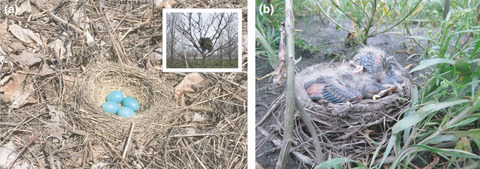
Mobile organisms often construct breeding structures in set locations, but American Robins that typically nest in trees or on human structures construct ground nests in predator-rich tree-filled arbors in Central Illinois, USA. Robins build these ground nests in the early breeding season, when tree nests are often quite visible to the human eye.
Directed endozoochorous dispersal by scavengers facilitate sexual reproduction in otherwise clonal plants at cadaver sites
- First Published: 26 January 2022
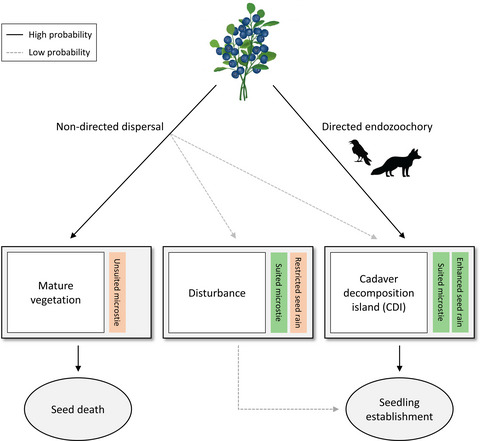
We disentangle the reproductive paradox of ericaceous berry-producing species and demonstrate a pathway of successful sexual reproduction in these otherwise clonal plants. Berry-consuming vertebrate scavengers provide directed endozoochorous dispersal toward cadavers, resulting in higher probability of seedling establishment at cadaver decomposition islands (CDIs). This mechanism allows plants to exploit the advantageous but ephemeral microsite provided by CDIs.
Sympatrically breeding congeneric seabirds (Stercorarius spp.) from Arctic Canada migrate to four oceans
- First Published: 21 December 2021
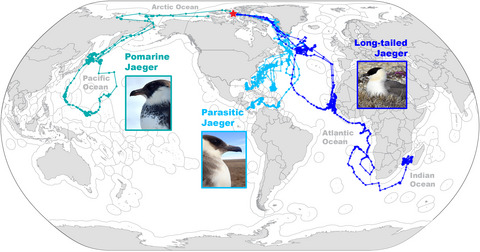
For seabirds nesting in the Nearctic, it is often difficult to predict which of the world's oceans birds will migrate to after breeding. Here, we report on three related predatory seabird species (Stercorarius spp.) that divided across four oceans following sympatric breeding at a central Canadian high Arctic nesting location. We also report on extensive nomadic movements over ocean during the postbreeding period (19,002 km) and over land during the prebreeding period (5578 km) by pomarine jaeger, an irruptive species whose full migrations have been a mystery.
Infection by dsRNA viruses is associated with enhanced sporulation efficiency in Saccharomyces cerevisiae
- First Published: 22 January 2022

Sporulation in yeast is induced by starvation; resource exploitation by endosymbiont should induce earlier sporulation. We find that the presence of two dsRNA viruses is linked to enhanced sporulation in Saccharomyces cerevisiae. However, further research is required to determine whether high sporulation leads to infection or infection leads to higher sporulation.
WORKING HYPOTHESIS
Are saltmarshes younger than mangrove swamps?
- First Published: 11 January 2022
Saltmarsh vegetation originated at least 35 million years after angiosperm mangroves.
A niche for null models in adaptive resource management
- First Published: 13 January 2022
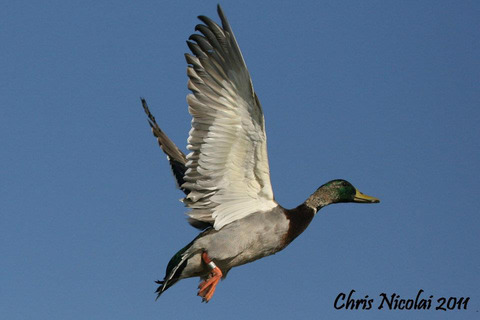
Ecological null models based on sound logic can be used as benchmarks for learning in ARM that trigger the need for new model parameterizations when prevailing models underperform the ecological null model. Identifying mechanistic models that surpass these benchmarks will improve learning through ARM and help guide decision making in a rapidly changing world.
REVIEW ARTICLES
A review of spatial capture–recapture: Ecological insights, limitations, and prospects
- First Published: 21 December 2021
RESEARCH ARTICLES
First insight of genetic diversity, phylogeographic relationships, and population structure of marine sponge Chondrosia reniformis from the eastern and western Mediterranean coasts of Tunisia
- First Published: 11 January 2022
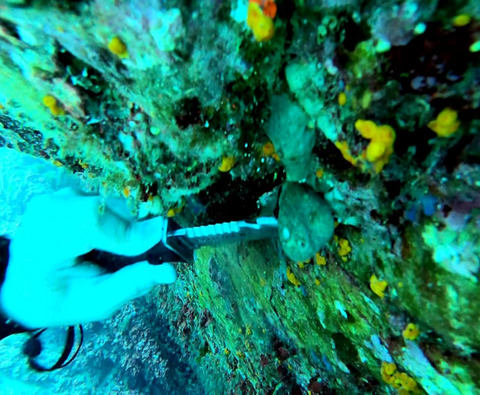
Both haplotype Network and the biogeographic analysis showed a structured distribution according to the geographic origin. C. reniformis populations are subdivided into two major clades: Western and Eastern Mediterranean. This pattern seems to be associated with the well-known discontinuous biogeographic area: the Siculo-Tunisian Strait, which separates two water bodies circulating with different hydrological, physical, and chemical characteristics.
Pieces in a global puzzle: Population genetics at two whale shark aggregations in the western Indian Ocean
- First Published: 25 January 2022
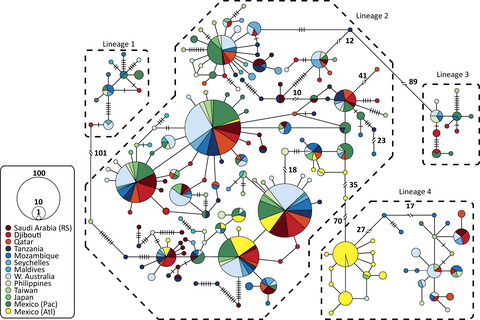
This study adds samples from whale sharks in two understudied regions, describes new microsatellite markers, proposes an incremental improvement to mitochondrial analysis, and provides a point of comparison to previous results from other aggregations. We include the first genetic sequences for whale sharks from the Mafia Island, Tanzania aggregation, and nearly quadruple those available from the Saudi Arabian Red Sea. These sequences were analyzed alongside 699 publicly available sequences from other aggregations. Our results demonstrate that our two study aggregations are derived from the same source population, despite strong ecological differences shown in previous work.
Rodent-mediated plant seed dispersal: What happens to the seeds after entering the gaps with different sizes?
- First Published: 11 January 2022
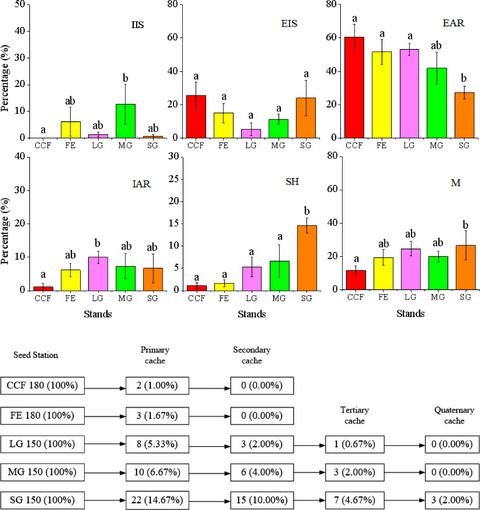
In general, it is accepted that gap formation significantly affects the placement of scatter-hoarded seeds by small rodents, but the effects of different forest gap sizes on the seed-eating and scatter-hoarding behaviors of small rodents remain unclear. Thus, we examined the effects of a closed canopy forest, forest edge, and gaps with different sizes on the spatial dispersal of Quercus variabilis acorns and cache placement by small rodents using coded plastic tags in the Taihang Mountains, China. We found that the proportions of scatter-hoarded seeds did not increase significantly as the gap size increased. In small-scale oak reforestation projects or research, creating small gaps to promote rodent-mediated seed dispersal may effectively accelerate forest recovery and successional processes.
Influence of multiple predators decreases body condition and fecundity of European hares
- First Published: 11 January 2022
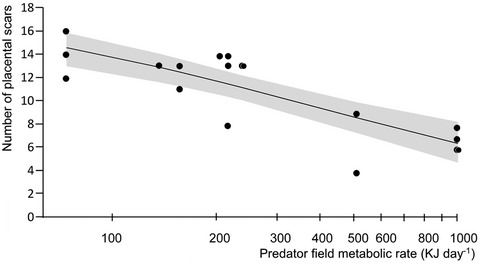
Our study is one of the few field studies to correlate the potential risk imposed by multiple predators to the fecundity of a mammal prey species over multiple reproduction cycles within a year. We suggest that the sum of the field metabolic rate can be a novel index that can be easily applied to other species systems. With our findings, our paper contributes to a better understanding of the risk effects of multiple predators on prey fitness.
Rhesus macaques compensate for reproductive delay following ecological adversity early in life
- First Published: 12 January 2022
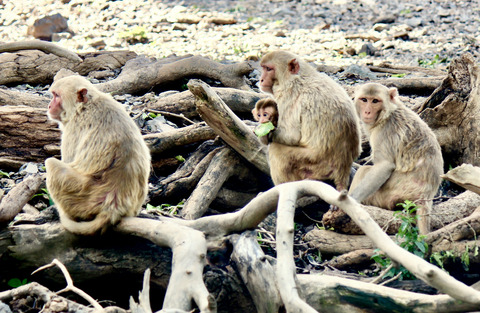
The Cayo Santiago rhesus macaque population presents a novel reproductive strategy where females experiencing major natural disasters early in life overcome their initial reproductive penalty and exhibit no major negative fitness outcomes. Such strategy suggests that investing more energy into development and maintenance at younger ages allows long-lived females experiencing early-life ecological adversity to reproduce at a mean rate equivalent to that of a typical female cohort later in life. Density at birth presents a more complex relation with reproduction that suggests females experiencing a population regulated at intermediate densities early in life escape density-dependent effects in reproduction.
Should we hail the Red King? Evolutionary consequences of a mutualistic lifestyle in genomes of lichenized ascomycetes
- First Published: 11 January 2022
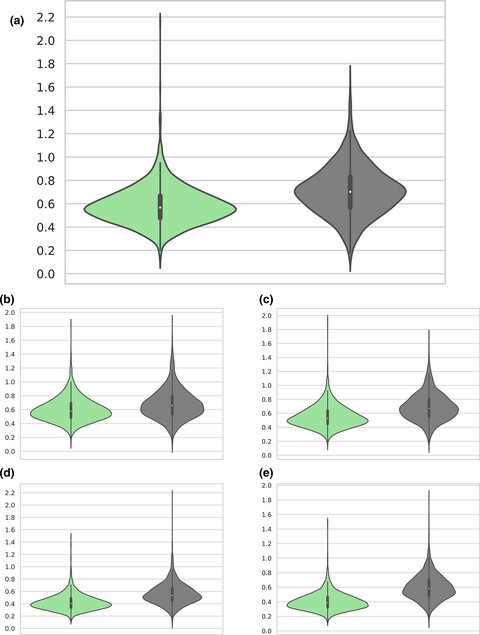
Lichens are a stable, mutualistic relationship of fungi and cyanobacteria and/or algae, which originated several times independently during the evolution of fungi. Our results show that independent lichenized clades are characterized by significantly slower rates for both synonymous and non-synonymous substitutions, as predicted by the Red King dynamic for mutualistic relationships. We hypothesize that this evolutionary pattern is connected to the lichen life cycle (longer generation time of lichenized fungi) rather than a result of different selection strengths on specific genes in lichenized fungal taxa.
Potential risk zone for anthropogenic mortality of carnivores in Gandaki Province, Nepal
- First Published: 12 January 2022

In this study, maximum entropy model was used to identify high-risk areas and explore the contribution of habitat attributes associated with carnivore mortality using the casualty database within the Gandaki province of central Nepal. We identified a 3704-km2 area within the province at high risk for carnivore casualty. This study identified that the common leopard was at the highest risk of mortality and therefore would benefit from the implementation of an action plan and species-specific conservation strategies, especially within identified high-risk zones.
Tree identity and diversity directly affect soil moisture and temperature but not soil carbon ten years after planting
- First Published: 12 January 2022
Toward a conceptual framework for managing and conserving marine habitats: A case study of kelp forests in the Salish Sea
- First Published: 12 January 2022
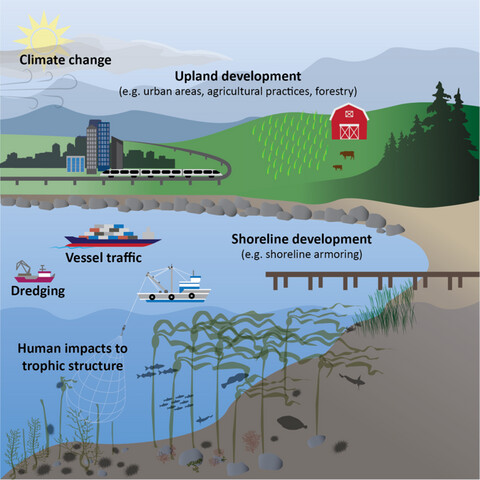
Data gaps and limited long-term monitoring have hampered attempts to identify and manage for specific drivers of decline across many ecosystems, despite often documented urgency to protect important habitats. To address these knowledge gaps, we gathered a focus group of experts paired with a comprehensive literature review to identify perceived direct and indirect stressors facing a threatened ecosystem. Our results revealed local research gaps and highlighted the potential to use expert knowledge for making informed decisions in the region.
Fine-scale ecological and anthropogenic variables predict the habitat use and detectability of sloth bears in the Churia habitat of east Nepal
- First Published: 13 January 2022
Size-dependent and environment-mediated shifts in leaf traits of a deciduous tree species in a subtropical forest
- First Published: 12 January 2022
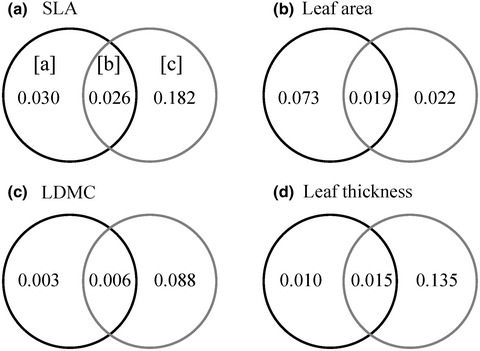
Plant size and environment independently shaped the variations in intraspecific leaf traits of Clausena dunniana in the subtropical karst forest of Maolan. Compared with plant size, the environment played a more critical role in shaping intraspecific leaf trait variations, and potentially also the underlying individual-level plant resource-use strategies.
Seedling survival simultaneously determined by conspecific, heterospecific, and phylogenetically related neighbors and habitat heterogeneity in a subtropical forest in Taiwan
- First Published: 12 January 2022
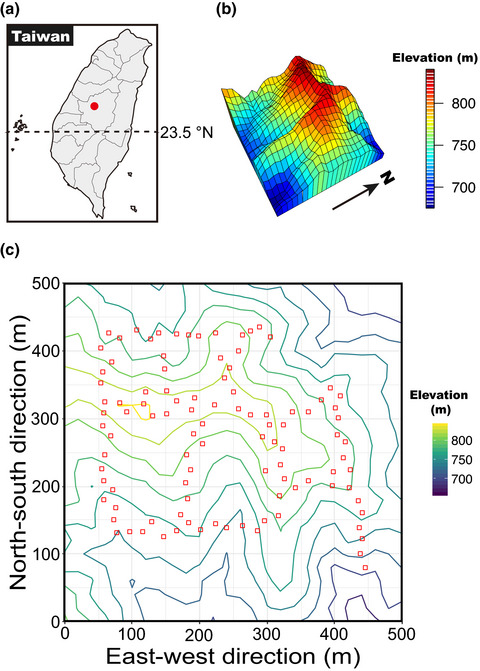
The relative importance of density dependence by conspecific, heterospecific, and phylogenetically related neighbors and habitat heterogeneity on seedling survival was evaluated in a subtropical forest. Our results revealed that the effects of CNDD, HPDD, PPDD, and habitat heterogeneity were prevalent in the LHC subtropical forest, and their relative importance varied among seedling ages. Our study highlights the importance to incorporate phylogenetic relatedness, seedling age, and habitat heterogeneity when investigating the impacts of density dependence on seedling survival that may contribute to species coexistence in seedling communities.
Vulture distribution and people perception of vultures in Pokhara Valley, Nepal
- First Published: 12 January 2022

Among the eight species of vultures, four of which are currently threatened with extinction in our study sites. White-rumped Vulture, Egyptian Vulture, and Himalayan Vulture were the most abundant species. Sites with food resources including a landfill and vulture restaurant had the highest vulture abundance. Almost all respondents were known about vultures and 98% of respondents reported seeing vultures in the wild.
Loss of the IR region in conifer plastomes: Changes in the selection pressure and substitution rate of protein-coding genes
- First Published: 12 January 2022
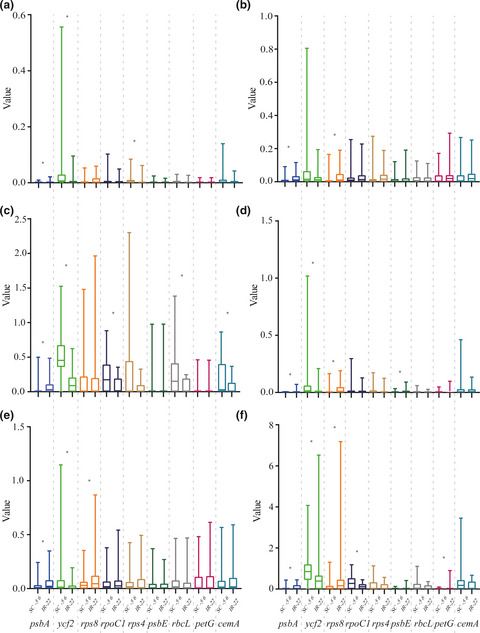
There are significant differences in the selection pressure of 12 genes and the evolution rate of 9 genes between conifer and non-conifer. This difference seems to be not related to the loss of typical IR regions but related to habitat. And the newly obtained short IR region plays a role in stabilizing the genome. The ycf2 located in the IR region showed a reduced substitution rate, providing evidence for the IR region a reduced substitution rate. PsbA is undergoing dynamic changes, and part of it enters the IR region, showing an abnormally high substitution rate.
Morphological, cytological, and molecular evidences for natural hybridization between Roegneria stricta and Roegneria turczaninovii (Triticeae: Poaceae)
- First Published: 12 January 2022
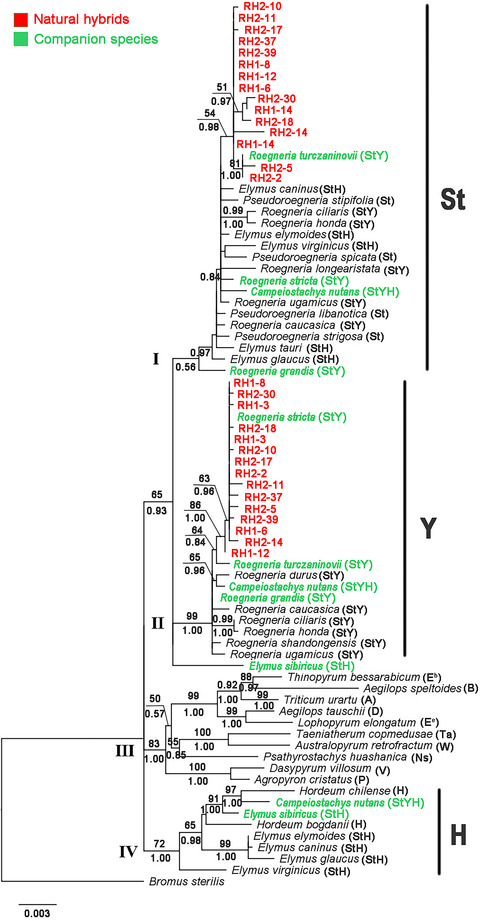
Our comprehensive analyses of natural hybrids, R. stricta, R. turczaninovii and the other Triticeae species, growing nearby from morphology, cytology, and molecular levels, provided support for the origin of natural hybrids. It demonstrates for the first time the existence of populations of natural homoploid hybrids in Roegneria.
Cattle grazing results in greater floral resources and pollinators than sheep grazing in low-diversity grasslands
- First Published: 13 January 2022
Sheep grazing resulted in significantly lower floral abundance compared with cattle grazing. However, butterfly communities were fairly homogenous and did not differ between grazers.
Trans-specific polymorphism and the convergent evolution of supertypes in major histocompatibility complex class II genes in darters (Etheostoma)
- First Published: 13 January 2022
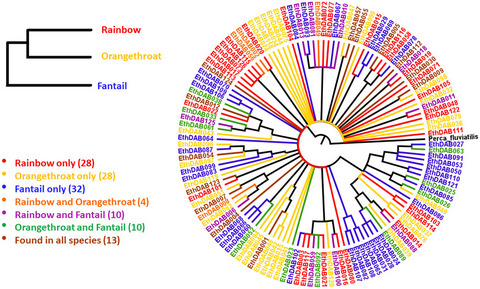
In this study, we used deep-sequencing techniques to characterize MHC class IIb gene diversity in three sympatric species of darters. We found at least 5 copies of the MHC gene in darters, with 126 genetic variants encoding 122 unique amino acid sequences, and we identified four supertypes based on the binding properties of proteins encoded by the sequences. Our findings show that trans-specific polymorphism occurs in darters, which suggests that balancing selection is acting at the genotype level. Supertypes, however, are most likely evolving convergently, as evidenced by the fact that alleles do not form monophyletic groups based on supertype.
A novel camera trapping method for individually identifying pumas by facial features
- First Published: 13 January 2022
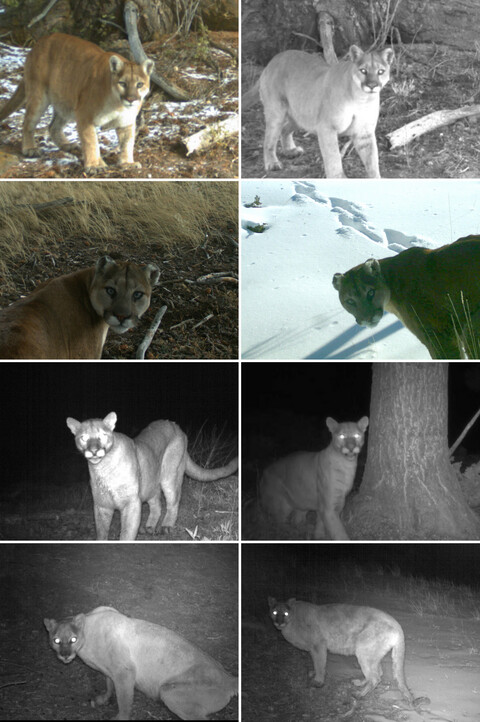
Pumas (Puma concolor) are a challenging species to individually identify in conventional camera trap images due to their lack of distinctive flank markings. Individual identity from facial features has been successful for other “unmarked” species, but has relied on handheld telephoto cameras, which are not suitable for elusive species such as pumas. We developed a camera trap accessory to elicit front-on camera trap images of pumas and found that it increased the likelihood of capturing puma face images; we also found an improvement in inter-rater agreement among experts assigning identity to pumas using face images.
Geographic variation and thermal plasticity shape salamander metabolic rates under current and future climates
- First Published: 15 January 2022
Long-term nitrogen enrichment mediates the effects of nitrogen supply and co-inoculation on a viral pathogen
- First Published: 15 January 2022
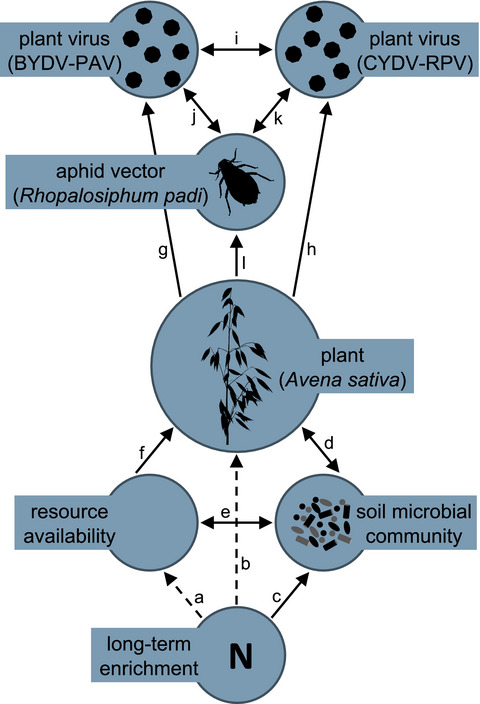
Soil microbes alter plant nutrient supply and plant defenses, both of which can modify plant-pathogen and pathogen-pathogen interactions. It is unclear if changes in soil microbial communities exposed to long-term nitrogen (N) enrichment affect their mediation of plant diseases. In a laboratory experiment, soil exposed to long-term N enrichment neutralized the negative effects of nitrogen and co-inoculation on infection incidence of a grass virus.
Comparative metagenomics analysis reveals how the diet shapes the gut microbiota in several small mammals
- First Published: 15 January 2022
Density and habitat use of one of the last jaguar populations of the Brazilian Atlantic Forest: Is there still hope?
- First Published: 15 January 2022

We evaluated the status of a jaguar population in one of the last stronghold habitats for its conservation in the Atlantic Forest, the Rio Doce State Park (RDSP). Our 2016/17 random survey revealed that jaguar density was the lowest obtained for the species across the Atlantic Forest. The 2017/18 systematic survey revealed density estimates slightly higher. We noticed that jaguar density increased three times from 2017/18 (0.55 ± SE 0.45 individuals/100 km2) to 2020 (1.61 ± SE 0.6 individuals/100 km2). Jaguar occupancy and detection probability were 0.40 and 0.08, respectively. Density estimates and occupancy probabilities represent not only a temporal snapshot assessment of jaguar population estimates and habitat use, but rather a first attempt to track population change over time.
Why flowers close at noon? A case study of an alpine species Gentianopsis paludosa (Gentianaceae)
- First Published: 15 January 2022

In this work, we report a repeatable floral closure rhythm, that is, open in the morning but close in early afternoon, first in an alpine species belonging to Gentianaceae. By monitoring the petal movement under treatments of changed environmental factors, detecting the microenvironment changing inside and outside flowers, and measuring the seed production, we found that endogenous rhythm regulates floral closure, but which was also strongly influenced by high/low temperature. The floral closure at noon provides a stable microenvironment inside the flower from possible damage of both high and low temperature. Interestingly, high temperature could promote a rapid floral closure, which is a new finding because low temperature, rather than the high temperature, is assumed as the key limiting environmental factor. Besides, we found that floral closure at noon could assure the seed production. We conclude that floral closure at noon of Gentianopsis paludosa might be an effective adaptive strategy to against unfavourable environmental conditions. This is the first report of this petal movement rhythm of Gentianaceae as we know.
Current biogeographical roles of the Kunlun Mountains
- First Published: 15 January 2022
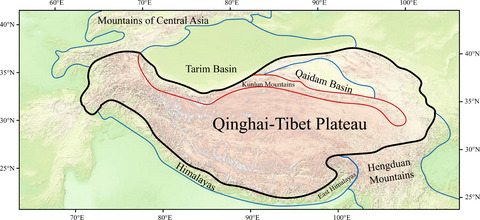
The biogeographical roles of the Kunlun Mountains were corridor and sink, and the corresponding key processes were species immigration and extinction. The extant biodiversity on the Kunlun Mountains has occurred through species recolonization after climatic fluctuations and glaciations during the Quaternary. The Kunlun Mountains also formed a barrier, representing a boundary among multiple floras, and converted the QTP into a closed physical geographical unit. The nearest taxon index indicated that habitat filtering may have played an important role in biodiversity patterns.
Physiological functional traits explain morphological variation of Ulva prolifera during the drifting of green tides
- First Published: 17 January 2022
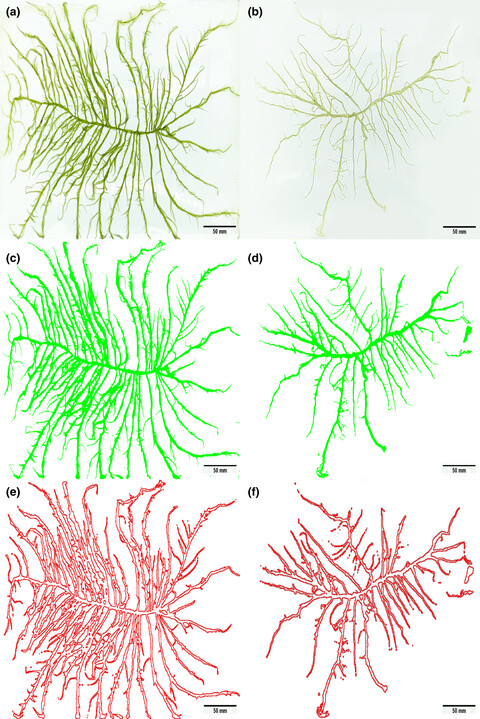
This manuscript highlighted a trade-off relationship between growth and reproduction existed in the northward drift of green tides caused by U. prolifera, and all the results suggested that physiological functional traits affected morphological variation of U. prolifera in different environmental conditions during the drifting. Principal findings of the manuscript: (1) previous studies demonstrated that large-scale green tides, mainly the genus Ulva prolifera, have occurred in the Yellow Sea of China since 2007 and obtain the highest biomass in Haizhou Bay. U. prolifera displayed distinct morphological differences during the drift northward. In order to find the reason about morphological variation of U. prolifera, we hypothesized that the thalli of U. prolifera adapt to the environmental changes by the variation in morphology to enhance nutrient uptake in northern Haizhou Bay (NH), an area with relatively less nutrients. (2) However, by comparing the surface area to volume ratio (SA:VOL), we found that the thalli in NH had a lower SA:VOL than those in SH, and SA:VOL had positive relationships with temperature and nutrients, contrary to the general hypothesis. (3) The novel results suggested that morphological differences of U. prolifera were the result of developmental state rather than environmental acclimation. Indicators of growth (Fv/Fm, Y(II)) and relative growth rate showed positive correlations with SA:VOL, whereas indicators of reproduction (reproductive allocation ratio) exhibited an opposite result and were negatively related to variation in tissue contents of C, N, P, and crude protein.
Non-zero-sum neutrality test for the tropical rain forest community using long-term between-census data
- First Published: 17 January 2022

In this study, we developed a new neutrality test, so-called “non-zero-sum Nsp test,” for local communities that implements non-zero-sum community dynamics and examines neutrality based on the number of new species between censuses. For an empirical test, we applied the test to real tropical tree communities in Panama and Malaysia, and it rejected neutrality in both communities.
Species-range-size distributions: Integrating the effects of speciation, transformation, and extinction
- First Published: 24 January 2022
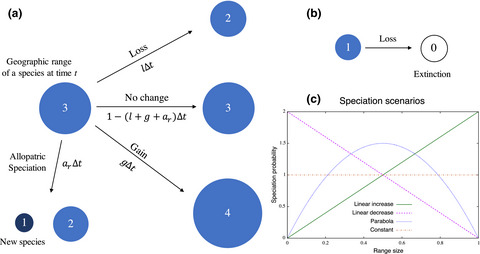
We developed a new mathematical framework to study species-range-size distributions, one in which allopatric speciation, transformation of range size, and the extinction process are explicitly integrated. Our model captures key dynamics thought to lead to known range-size distributions. We also fitted the model to empirical range-size distributions of birds, mammals, and beetles.
Simulating climate change in situ in a tropical rainforest understorey using active air warming and CO2 addition
- First Published: 24 January 2022
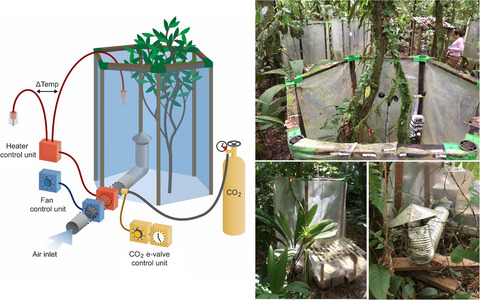
We introduce an effective experimental system for studying plant responses to warming and CO2 enrichment in situ in tropical rainforests using open-top chambers and forced-air warming. The system is suitable for treating shrubs, saplings, and epiphytes, while ecosystem-level studies may need infrared heating and free-air CO2 enrichment. Developing in situ experiments in rainforests is urgently needed to help understand the response of these ecosystems to global change.
Novel hair snare and genetic methods for non-invasive bobcat detection
- First Published: 24 January 2022
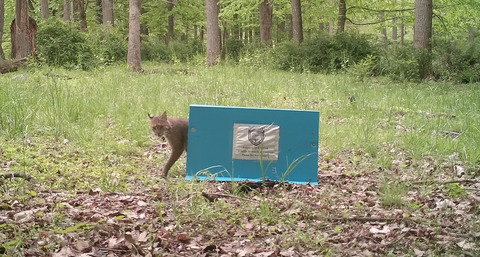
Gathering large-scale population information on elusive carnivores, like bobcats, can be difficult. We developed a novel hair snare to non-invasively sample bobcats for use in capture–recapture studies at a large spatial scale. In addition, we designed felid- and bobcat-specific qPCR primers to assist in determining the species of origin of collected hair samples.
Herbivory in a changing climate—Effects of plant genotype and experimentally induced variation in plant phenology on two summer-active lepidopteran herbivores and one fungal pathogen
- First Published: 25 January 2022
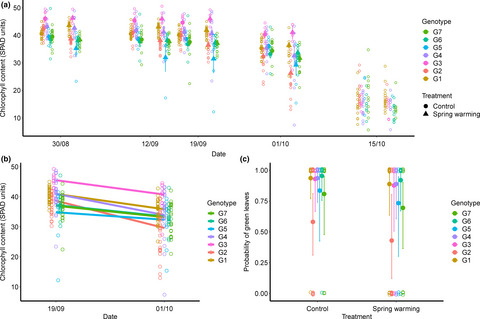
We found that spring and autumn phenology differed among plant genotypes, but that neither the performance of the summer active herbivores nor the fungal pathogen were influenced by host plant phenology. This implies that herbivores active in summer can – at least to a certain extent – tolerate climate-induced shifts in host plant phenology.
Effects of climate change and pollen supplementation on the reproductive success of two grassland plant species
- First Published: 24 January 2022
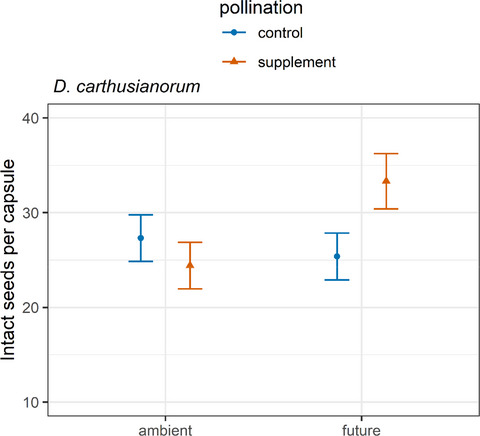
In this study, we conduct pollen supplementation experiments on two plant species within a climate change experiment in which precipitation is manipulated in the context of a regional climate change scenario. Dianthus carthusianorum produced more seeds in future climate conditions independent of the season, but only when given supplemental pollen. Both species showed an increased reproduction in summer compared with the fall, but we did not find any evidence for our expectation of higher pollen limitation in the future climate and fall season.
Comparing genome scans among species of the stickleback order reveals three different patterns of genetic diversity
- First Published: 24 January 2022
Reproduction ecology of an emerging fishery resource, the amphibious mudskipper Periophthalmus chrysospilos, in the Mekong Delta
- First Published: 24 January 2022
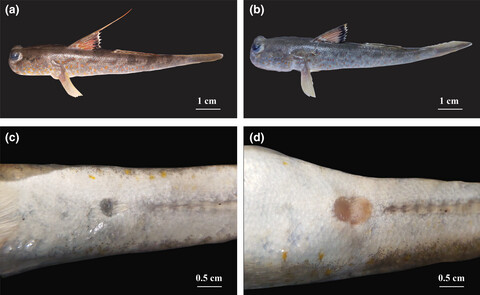
A combination of GSIs and the monthly appearance of mature gonads suggest that this species reproduces throughout the year, with peak from July to October. This species exhibits sexual and spatial variation in size at first maturity (Lm) as Lm is 6.2–8.6 cm in males and 6.4–7.3 cm in females. The batch fecundity (F = 2614 to 23,465 eggs/female) exhibits non-normal distribution and varies with site, with the highest values at Dam Doi, Ca Mau (13,336 ± 1279 SE) and the lowest at Tran De, Soc Trang (6654 ± 851 SE).
A meta-analysis of the effects of climate change on the mutualism between plants and arbuscular mycorrhizal fungi
- First Published: 24 January 2022
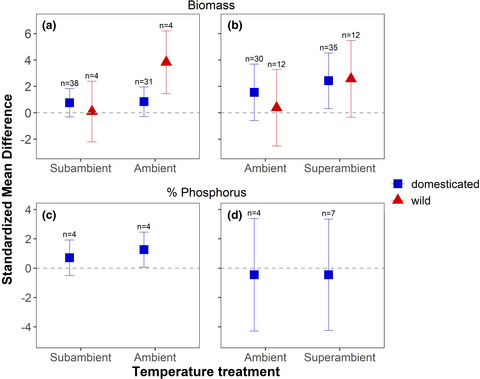
We conducted a meta-analysis of experiments that quantified plant growth response to AM fungal inoculation under contrasting temperature and CO2 treatments. We found that the mycorrhizal mutualism was likely strengthened by past warming due to climate change. However, mycorrhizal growth response may not have been altered by increases in atmospheric CO2 from the past to the present, nor will it likely to be affected by increases in CO2 forecasted for the future.
Insect herbivory increases from forest to alpine tundra in Arctic mountains
- First Published: 24 January 2022
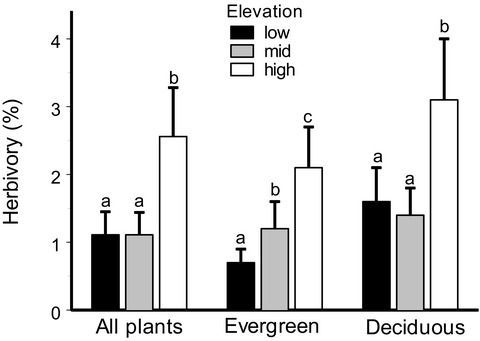
Our study of insect herbivory along six elevational gradients located in three Arctic mountain ranges demonstrated that losses of plant foliage to insects increased with increase in elevation across 10 woody species. We suggest that this elevational pattern is typical for high-latitude mountains, where inverse temperature gradients, especially at the soil surface, are common.
Intergrading reef communities across discrete seaweed habitats in a temperate–tropical transition zone: Lessons for species reshuffling in a warming ocean
- First Published: 24 January 2022
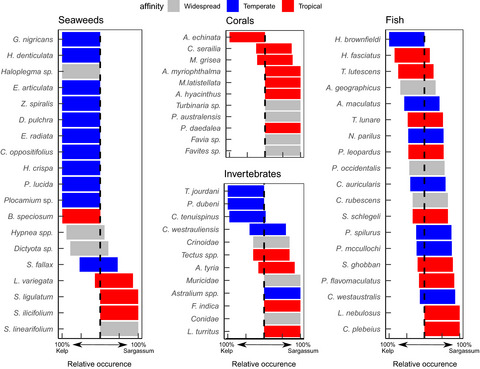
We investigated seaweed, coral, mobile invertebrate, and fish communities in quintessentially cool and warm seaweed habitats in a transition zone. There was a discrete separation between the temperature affinity of sessile benthic organisms. This separation was not reflected in the relative abundance of fish and mobile invertebrates in each habitat.
Genetic assessment reveals inbreeding, possible hybridization, and low levels of genetic structure in a declining goose population
- First Published: 24 January 2022
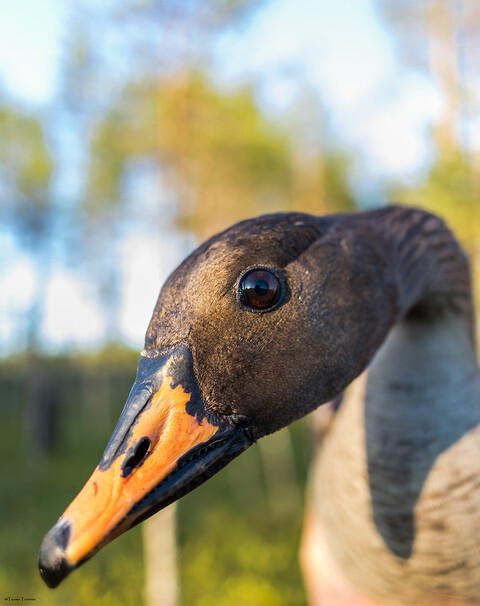
We studied large-scale genetic population structure of declining taiga bean geese (Anser fabalis fabalis) in their breeding habitat using a citizen-science approach. Over 2000 non-invasively collected feathers were genotyped with microsatellite markers, and mitochondrial DNA sequences were analyzed in the 491 individual geese identified. We found very limited population structure, signs of inbreeding, and surprisingly, indications of hybridization with another goose species, the pink-footed goose (Anser brachyrhynchus).
Similar cost of Hamiltonella defensa in experimental and natural aphid-endosymbiont associations
- First Published: 24 January 2022
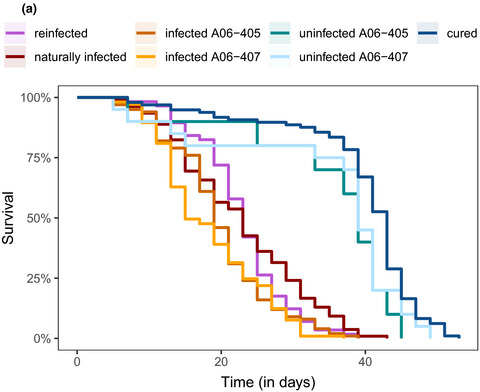
In this experiment, we show that removing isolates of the bacterial endosymbiont Hamiltonella defensa from their natural aphid host clones with antibiotics results in a fitness gain that is comparable to the fitness loss from their introduction into new clones. This suggests that estimating costs by transfecting endosymbiont isolates into a shared host genotype does not lead to gross overestimates of their realised costs.
Safe from sunburn: The divergent diel pattern of a Hydrophis sea snake
- First Published: 24 January 2022
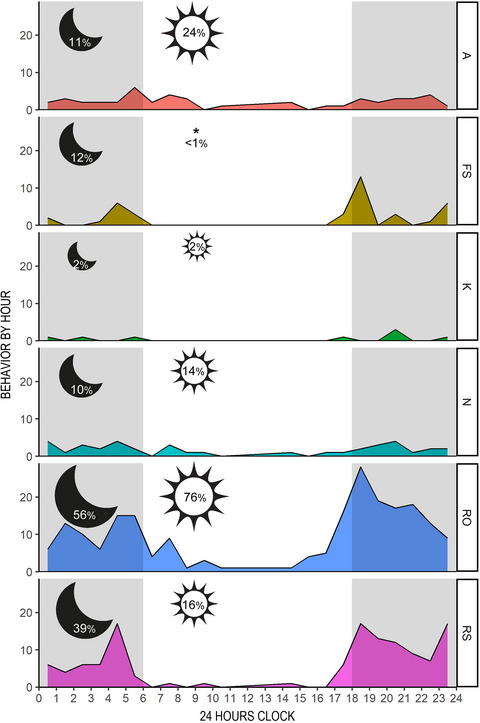
We investigated the activity and behavior patterns of the xanthic sea snake, Hydrophis platurus xanthos, which is endemic to the warm fiord-like embayment of Golfo Dulce, Costa Rica. Data obtained from a systematic visual survey over five 24-h cycles along with sighting data from several previous studies showed H. p. xanthos to evince a nocturnal diel pattern with marked crepuscular peaks. As this circadian rhythm differs noticeably from its taxonomic parent (H. p. platurus is reported as diurnal across its Indo-Pacific range) and no congeners have been categorized as crepuscular, our work offers insights into the potential role of environmental conditions in shaping animal activity.
Quantifying song behavior in a free-living, light-weight, mobile bird using accelerometers
- First Published: 23 January 2022
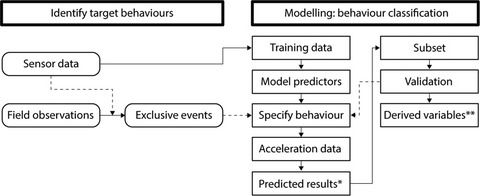
We used light-weight accelerometers to register the vocal output of European Nightjars (Caprimulgus europaeus) via body vibrations. We developed a classification model to identify four behaviors (rest, sing, fly, and eat) from accelerometer data and used audio recordings to validate the classification of song behavior. We show that accelerometer-based identification of vocalizations could serve as a promising tool to study communication in free-living, small-sized birds and demonstrate possible limitations of audio recorders to investigate individual-based variation in song behavior.
Sex, body size, and boldness shape the seasonal foraging habitat selection in southern elephant seals
- First Published: 26 January 2022

Identifying factors driving individual differences in habitat selection is needed to understand population spatiotemporal dynamics essential in wildlife management and conservation. Here, we found that elephant seals in the Southern Ocean vary their seasonal foraging habitat selection with sex, body size, and boldness.
Assessment of drivers of spatial genetic variation of a ground-dwelling bird species and its implications for conservation
- First Published: 20 December 2021
Can young-of-the-year invasive fish keep up with young-of-the-year native fish? A comparison of feeding rates between invasive sticklebacks and whitefish
- First Published: 23 January 2022
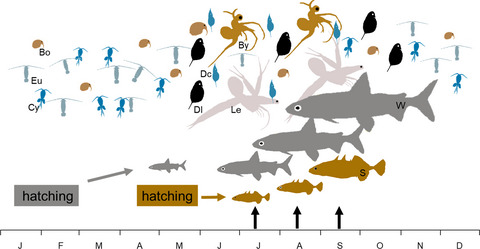
The juvenile period of fish is crucial for their establishment in a new habitat as well as for the grazing impact of fish on prey communities. Here, we show that juveniles of an invasive species, sticklebacks, do have similar feeding rates on various zooplankton species compared to native whitefish despite the latter are specialized planktivores and advanced sticklebacks in growth during the seasonal course. Our results suggest that the invasion of sticklebacks and partial replacement of whitefish should not result in changing relative feeding pressures on the various zooplankton species.
Patterns of thermal adaptation in a globally distributed plant pathogen: Local diversity and plasticity reveal two-tier dynamics
- First Published: 26 January 2022
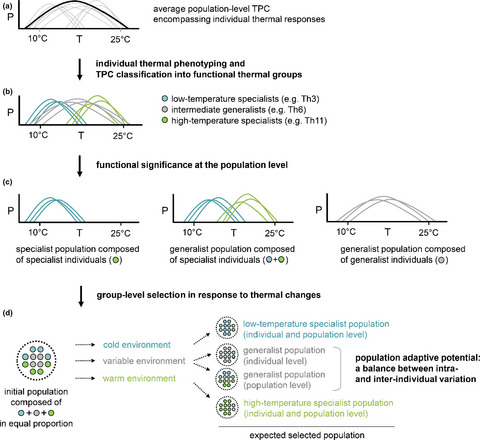
We investigated the diversity of thermal responses in fungal plant populations sampled within the Euro-Mediterranean region. We highlighted (i) a high degree of individual plasticity and variation in sensitivity to temperature conditions across spatiotemporal scales and populations; and (ii) geographic variation in thermal response among populations, with major alterations due to seasonal patterns. The seasonal shifts in functional composition suggest that populations are locally structured by selection and thus reveal two-tier adaptive dynamics.
The effect of oil palm-dominated landscapes on the home range and distribution of a generalist species, the Asian water monitor
- First Published: 26 January 2022
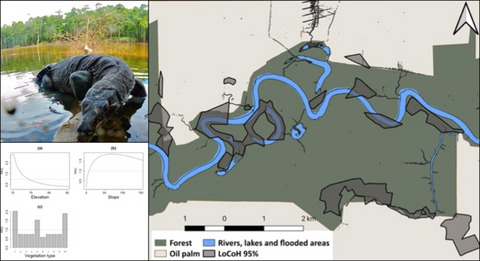
We use the Asian water monitor lizard as a model species to understand how oil palm-dominated landscapes may alter natural patterns of home range in generalist species. We described how relevant is the role of the natural forest around (and within) oil palm plantations as source of protection and to facilitate the dispersion of the population within the landscape.
Seed rain and soil seed bank in Chinese fir plantations and an adjacent natural forest in southern China: Implications for the regeneration of native species
- First Published: 26 January 2022
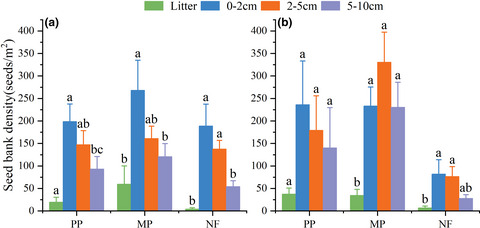
Our findings demonstrated that seeds from native tree species in the natural forest were present in the plantation seed rain and seed banks. Furthermore, species composition differed across seed rain, seed banks, and aboveground vegetation. The two seed sources are valuable for restoring species diversity in plantations and achieving sustainable forest management.
A domestic plant differs from its wild relative along multiple axes of within-plant trait variability and diversity
- First Published: 26 January 2022
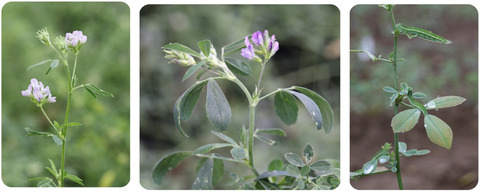
Studies of domestication and agroecology often study change in whole-plant or average traits; however, plants also have characteristic levels of trait variability among their repeated parts, which can be heritable and mediate ecological interactions such as herbivory. Here, we document differences in within-plant, among-leaf variability in nutritive and defensive traits between domestic and wild alfalfa. Differences in trait variability were of comparable or greater magnitude than differences in trait means, suggesting that this underappreciated trait may be shaping critical biotic interactions in agroecosystems.
Evolution of flowering time in a selfing annual plant: Roles of adaptation and genetic drift
- First Published: 26 January 2022
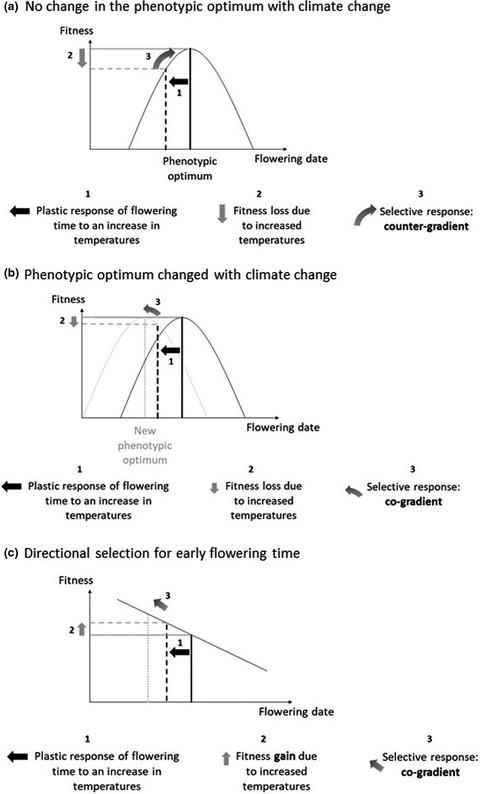
Resurrection studies are a useful tool to measure how phenotypic traits have changed in populations and they allow testing whether these traits modifications are a response to selection caused by an environmental change. Selfing, through its reduction of effective size, could challenge the ability of a population to adapt to environmental changes. Here, we used a resurrection study to test for adaptation in a selfing population of Medicago truncatula, by comparing the genetic composition and flowering across 22 generations.
Using retrospective life tables to assess the effect of extreme climatic conditions on ungulate demography
- First Published: 24 December 2021
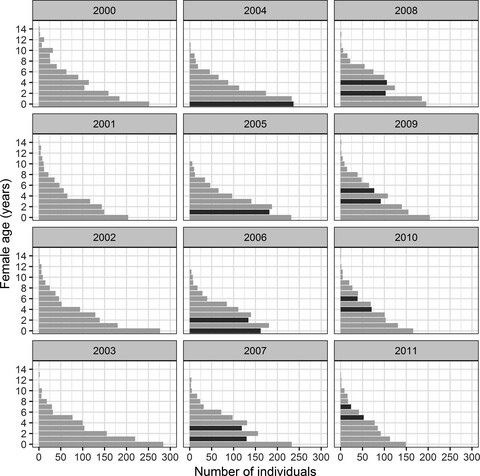
Retrospective life tables for wild populations of animals might be a useful tool to assess future demographic changes under the context of climate change. Using this methodology, we provided an empirical quantification of the demographic effects of severe drought events for a wild red deer population.
Evidence of nutrient translocation in response to smoke exposure by the East African ant acacia, Vachellia drepanolobium
- First Published: 28 October 2021
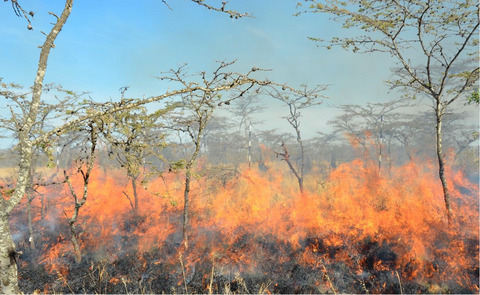
We exposed a fire-adapted savanna tree, Vachellia (=Acacia) drepanolobium, to smoke and compared nutrient concentrations in leaf and root tissues to unexposed controls. Our findings suggest trees may detect smoke and respond by translocating nutrients from leaves to roots, a potential mechanism for improving survival and post-fire resprouting.
Effects of intraspecific competition and body mass on diet specialization in a mammalian scavenger
- First Published: 11 January 2022
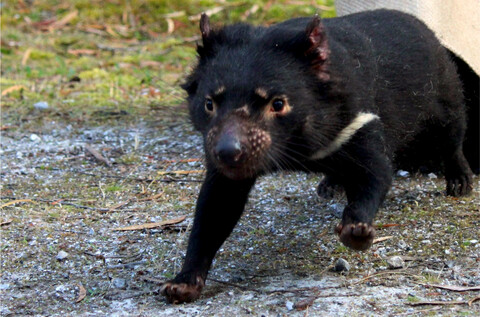
We used stable isotope analysis to analyze the degree of specialization in the diet of the Tasmanian devil, one of few mammalian species to develop adaptations for scavenging. We found that the majority of devils were dietary specialists and that only small individuals in competitive populations were true generalists. Devils may be unique among scavenging mammals in the extent to which they can specialize their diets, having been released from the competitive pressure of larger carnivores.
Drivers of alien species composition in bird markets across the world
- First Published: 24 December 2021
Standard metabolic rate does not associate with age-at-maturity genotype in juvenile Atlantic salmon
- First Published: 21 December 2021
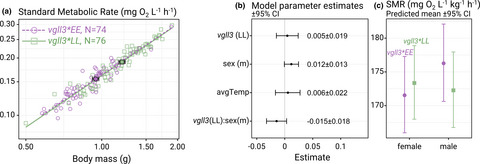
We show that vgll3, a gene known to have significant effects on Atlantic salmon (Salmo salar) life-history strategy, does not associate with standard metabolic rate in salmon juveniles. This indicates that the effects of vgll3 on age at maturity is not strongly related to maintenance energy expenditure or related physiological mechanisms at the life stage and conditions used in this study.
Retrospective stable isotopes of vertebrae reveal sexual ontogenetic patterns and trophic ecology in oceanic whitetip shark, Carcharhinus longimanus
- First Published: 23 December 2021
In this study, 25 oceanic whitetip sharks, Carcharhinus longimanus, were collected from the Central and Eastern Pacific. Retrospective stable isotope analysis of vertebrae was used to evaluate the feeding habits and niche breadth differences between the sexes. The results showed that the oceanic whitetip shark is a long-lived oceanic pelagic shark with generalist feeding behavior.
Testing the effectiveness of genetic monitoring using genetic non-invasive sampling
- First Published: 27 December 2021
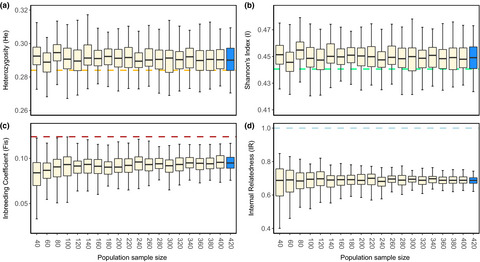
Genetic non-invasive sampling is a powerful tool for monitoring free-ranging populations. Here we test the accuracy of using non-invasively sampled DNA for downstream individual and population level analysis. We find that non-invasive genetic sampling can provide accurate genetic measures, depending on the questions being investigated.
Capture vulnerability of sea turtles on recreational fishing piers
- First Published: 21 December 2021
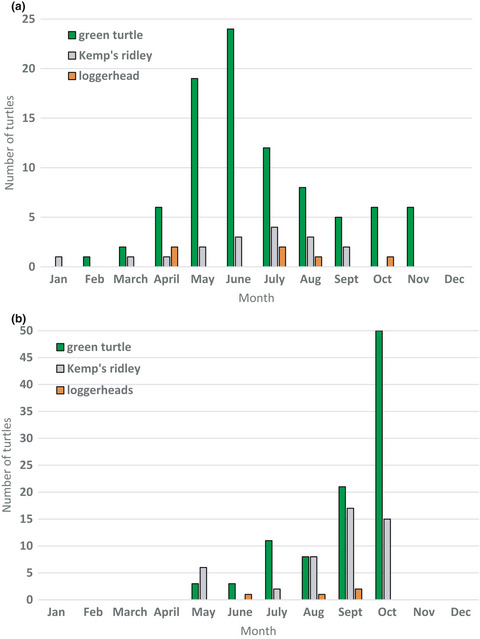
We examined species composition, timing of captures, morphological variables including body size and head width, and body condition of sea turtles captured from a recreational fishing pier in the northern Gulf of Mexico and of sea turtles captured in the waters adjacent to the pier. Green turtles were captured most frequently in the net and on the pier. Turtles captured from the pier were larger than those captured in the net.
Genetic structure and dispersal in peripheral populations of a marine fish (Pacific cod, Gadus macrocephalus) and their importance for adaptation to climate change
- First Published: 21 December 2021
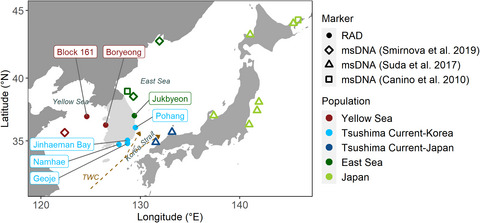
When located at the equatorial edge of a species’ range, small and isolated peripheral populations may harbor genetic diversity related to survival and reproduction at higher temperatures—a critical resource for adaptation to warming oceans. We use restriction site-associated DNA (RAD) sequencing and individual assignment to reveal west-to-east movement of Pacific cod (Gadus macrocephalus) between highly differentiated peripheral populations around the Korean Peninsula. A total of 87 RAD loci had allele frequencies decisively correlated with strong marine temperature gradients between the warmer southern population and the cooler eastern and western populations. Our data suggest asymmetrical dispersal and gene flow, potentially involving adaptive alleles, between peripheral populations of a marine fish inhabiting markedly different thermal regimes.
DNA metabarcoding reveals introduced species predominate in the diet of a threatened endemic omnivore, Telfair’s skink (Leiolopisma telfairii)
- First Published: 21 December 2021
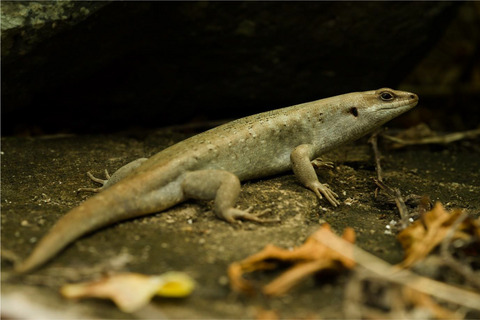
Telfair's skinks are keystone omnivores found on Round Island, Mauritius. Using a multimarker DNA metabarcoding approach, we identify that this endemic species frequently consumes introduced species, which comprise almost 50% of all prey detections. This provides a valuable insight into how introduced species may fit into the food web in their introduced range.
Acute and lagged fitness consequences for a sagebrush obligate in a post mega-wildfire landscape
- First Published: 24 December 2021
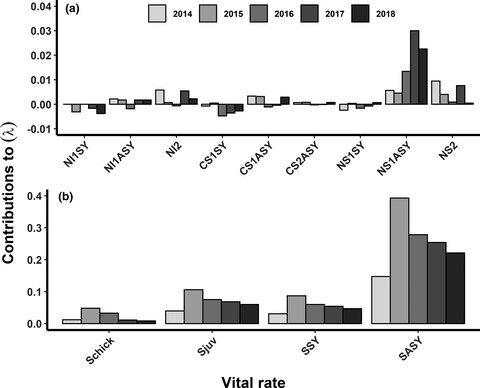
Chick survival and female survival were low for Greater sage-grouse a megafire, compared to values reported throughout their range. Greater sage-grouse exhibited variation in demographic tactics; however, adult female survival explained most of the variation in the finite rate of population change, which reflected a declining population in 3 of 6 years following the fire.
Prey life-history influences the evolution of egg mass and indirectly reproductive investment in a group of free-living insect predators
- First Published: 27 December 2021
Interactions with soil fungi alter density dependence and neighborhood effects in a locally abundant dipterocarp species
- First Published: 24 January 2022
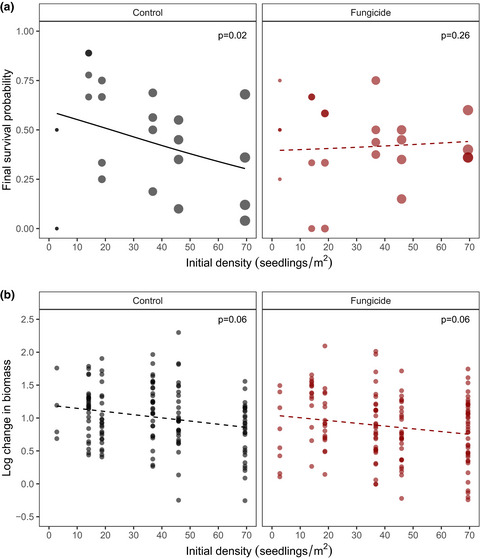
We present a rare-field experiment in which we manipulated both the recruitment neighborhood (whether or not seedlings recruited in proximity to adult conspecifics) and seedling density to explore how they interact to influence the growth and survival of a dominant ectomycorrhizal tree species in a Bornean tropical rainforest. Our results provide support for the idea that dominant species in diverse forests may escape the localized recruitment suppression that limits abundance in rarer species and that ectomycorrhizal fungi play an important role in reducing CNDD for some tropical trees.
Does ant–plant mutualism have spillover effects on the non-partner ant community?
- First Published: 24 January 2022
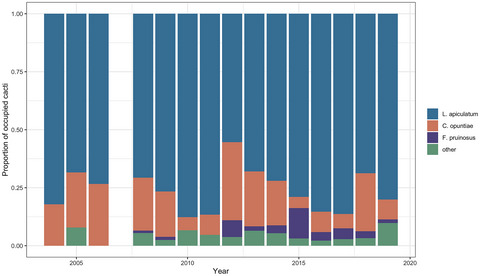
Theory predicts that community composition and diversity should be affected by mutualist promotion of partner relative abundance and shifts in a competitive hierarchy. Despite these clear predictions and evidence of promotion of the dominant mutualist ant partner, we did not find strong spillover effects on the ant community composition or diversity.
Morphometry of two cryptic tree frog species at their hybrid zone reveals neither intermediate nor transgressive morphotypes
- First Published: 27 January 2022
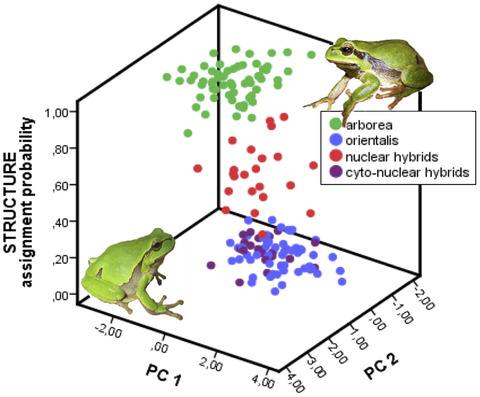
We associate microsatellite-based genotypes with morphometrics-based morphotypes of two tree frog species of the Hyla arborea group, sampled across a hybrid zone in Poland, to understand whether the genetically differentiated parental species also differ in morphology between each other and their hybrids and whether secondary contact leads to the evolution of intermediate or transgressive morphotypes. We find that morphotypes of both parental species and hybrids differ from each other. Importantly, hybrid morphotypes are neither intermediate nor transgressive but found to be more similar to H. orientalis than to H. arborea.
Biodiversity influences the effects of oil disturbance on coastal ecosystems
- First Published: 24 January 2022
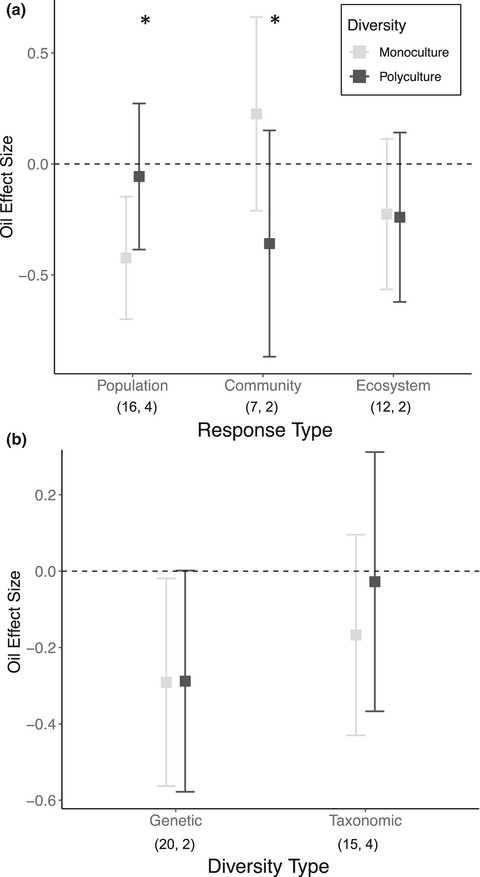
Oil spill impacts on marine ecosystems can vary greatly: from negligible to total destruction. The extent of impacts depends on a variety of factors including oil properties and habitat characteristics; yet, whether local diversity can also enhance resistance and resilience is unclear. Using a meta-analysis, we found that diversity can reduce the negative effects of oiling, but this diversity effect was primarily evident for within-trophic-level responses, and stronger for taxonomic than genetic diversity. Together, highlighting that conserving and maintaining biodiversity may provide a benefit to marine ecosystems in the face of future perturbations.
Metabarcoding reveals massive species diversity of Diptera in a subtropical ecosystem
- First Published: 23 January 2022
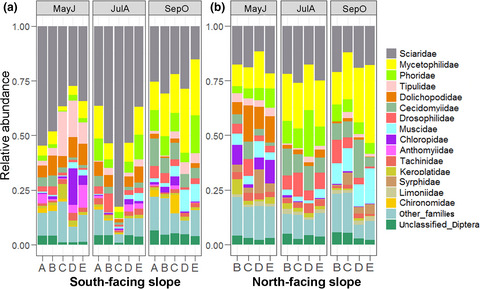
Using DNA metabarcoding technology, we investigated the diversity of Diptera communities of a subtropical ecosystem of Tianmu Mountain in eastern China. The result demonstrates the extraordinary species (5092 OTUs) and phylogenetic (72 families) diversity of Diptera, particularly in Cecidomyiidae, Sciaridae, and Phoridae that combined represented 53.6% of total OTUs, while 52 families each contained more than 95% unknown or unidentifiable species, and many more species than recognized at these sites in morphology-based studies (“excess taxa”). The community structure of Diptera was significantly affected by aspect, seasonality, and, to a lesser extent, elevation.
Hybrid zone of a tree in a Cerrado/Atlantic Forest ecotone as a hotspot of genetic diversity and conservation
- First Published: 22 January 2022
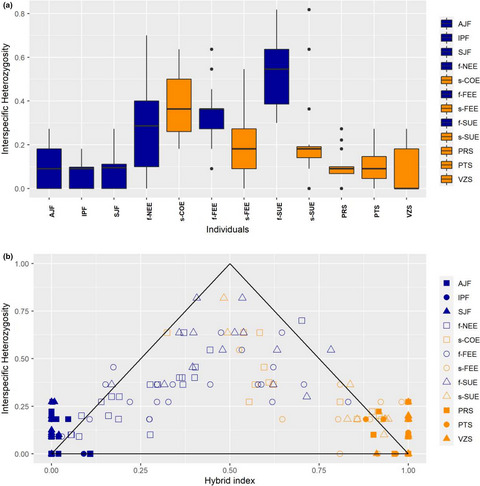
Here, we investigated the evolutionary divergence between the savanna and forest ecotypes of the tree Plathymenia reticulata in the Cerrado, the largest Neotropical savanna, and the Brazilian Atlantic Forest. We found that the ecotonal areas between the Cerrado and the Atlantic Forest constitute a hybrid zone in which a diversity of hybrid classes were observed, most of them corresponding to second generation hybrids. The high genetic diversity found in the ecotonal hybrid zone supports the view of ecotones as important areas for the origin and conservation of biodiversity in the Neotropics.
Earlier than expected introductions of the Bemisia tabaci B mitotype in Brazil reveal an unprecedented, rapid invasion history
- First Published: 23 January 2022
The soil microbiome increases plant survival and modifies interactions with root endosymbionts in the field
- First Published: 24 January 2022
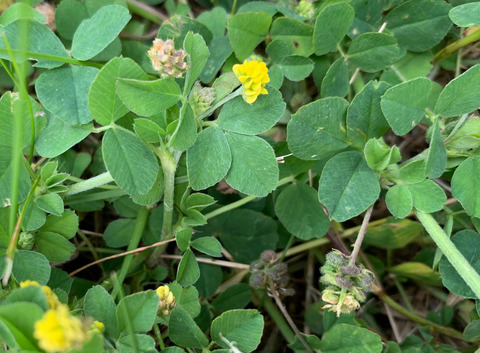
We show that the soil microbial community affects survival and interactions with two major root endosymbionts (nitrogen-fixing bacteria and parasitic root-knot nematodes) in the field in the legume Medicago lupulina. Our experiment demonstrates that the significant fitness consequences of host-associated microbial communities that have been observed in the laboratory persist under natural conditions, and suggests that the role of soil microbial communities in mediating key endosymbioses merits future research.
Habitat use and foraging parameters of breeding Skylarks indicate no seasonal decrease in food availability in heterogeneous farmland
- First Published: 26 January 2022
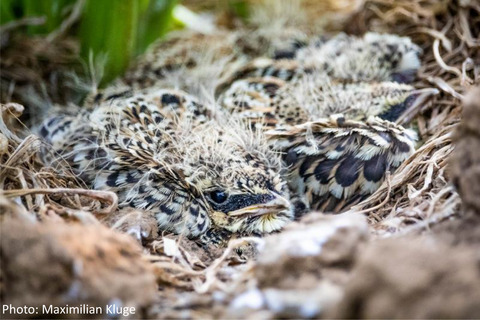
The Eurasian Skylark (Alauda arvensis) is thought to suffer from a decrease in food availability .in European farmland during the breeding season. In contrast to this, our multivariate analyses of habitat selection and foraging parameters of chick-raising pairs in Central Europe suggest no seasonal food shortage. We interpret our findings as being a consequence of the heterogeneous composition of our study area and highlight the importance of crop diversity in Skylark conservation.
CYP1A expression in freshwater fish of western New York as an indicator of pollution levels
- First Published: 25 January 2022
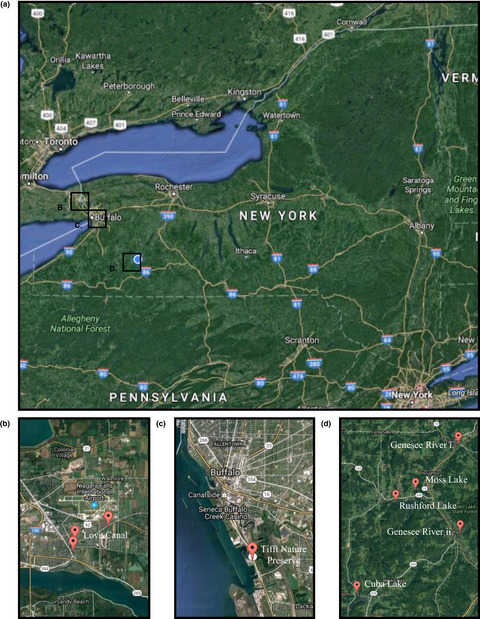
Biomarker CYP1A expression was measured and analyzed in twelve fish species across seven sites in western New York. We aimed to explore whether CYP1A analysis demonstrated an accurate reflection of site health or displayed characteristic adaptive efforts. Conclusions were made based on known contaminant data and known remediation efforts.
Life-history traits and fitness of plateau pika (Ochotona curzoniae) in alpine meadow ecosystem
- First Published: 25 January 2022
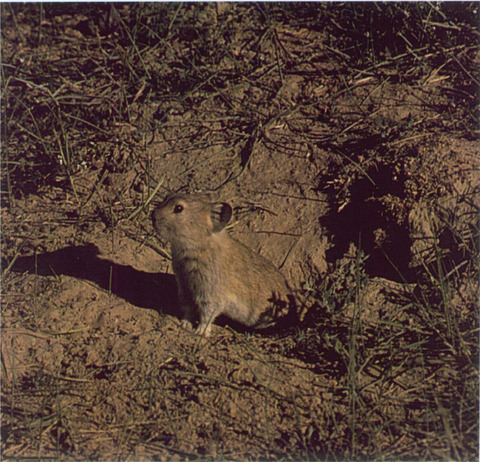
Plateau pika is an endemic mammal living at the alpine meadow ecosystem in Qinghai–Tibet Plateau. We studied plateau pika life history by mark–recapturing plateau pika in the field and by tracking and recording a reproductive population in half-captivity. The results showed plateau pika adopted quick growth strategy and supported our hypotheses that fitness of plateau pika to its habitat was lower than those of many other mammal species, etc.
Fire disturbance effects on plant taxonomic and functional β-diversity mediated by topographic exposure
- First Published: 25 January 2022

We investigated how fire disturbance influenced plant taxonomic and functional diversity in Mountain steppes of Golestan National Park, in northeastern Iran. In the studied area, a fire occurred in the late summer of 2013. Our results suggest that taxonomic and functional α- and β-diversity have contrasting responses to fire illustrating the need to consider both dimensions to understand how disturbance impacts plant communities. Burned (left) and control (right) sites in the south exposure of study site.
RAD-tag and mitochondrial DNA sequencing reveal the genetic structure of a widespread and regionally imperiled freshwater mussel, Obovaria olivaria (Bivalvia: Unionidae)
- First Published: 26 January 2022

Using RADseq and mitochondrial sequencing, we investigated the genetic diversity and structure of an imperiled freshwater mussel species, Obovaria olivaria, that uses a similarly imperiled host fish, Acipenser fulvescens. We show that O. olivaria is partially subdivided into northern and southern groups by the Great Lakes, but that overall structure is largely continuous and driven by geographic (river) distance between populations.
Investigating population dynamics from parentage analysis in the highly endangered fan mussel Pinna nobilis
- First Published: 25 January 2022
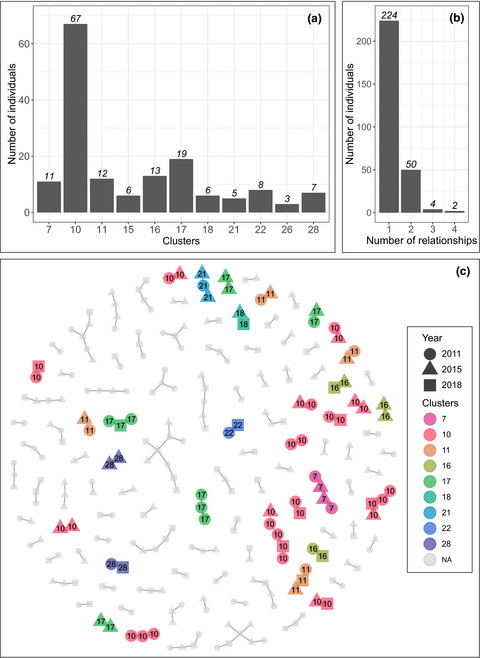
This study documents the family structure of a pelagic spawner, Pinna nobilis, endemic of the Mediterranean Sea, which is facing a major crisis that threatens its survival as most of its populations have been decimated by a parasite, Haplosporidium pinnae. Based on the survey of a wild population during several years and using parentage analyses, we focused on recruitment processes which drive the replenishment of the local population. These results will have serious implications in management plans, particularly in the context of the present pandemic and considering that a number of rescue projects, that include reintroduction perspectives, are emerging in several Mediterranean countries.
Ranging patterns and factors associated with movement in free-roaming domestic dogs in urban Malawi
- First Published: 27 January 2022

In Africa, rabies virus is mostly maintained in populations of free-roaming domestic dogs (FRDD) that are predominantly owned. Characterizing the roaming behavior of FRDD can provide relevant information to understand disease spread and inform prevention and control interventions. In our study, we tracked with GPS collars 168 FRDD in Blantyre city, Malawi, to estimate their home range and identify predictors of HR size.
COMMENTARY
Scale dependency in native–exotic richness relationships revisited
- First Published: 12 January 2022
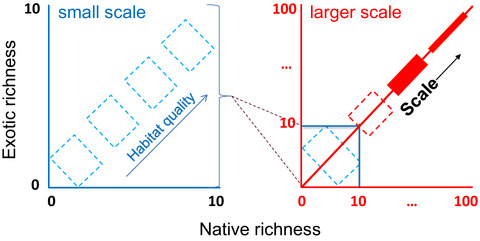
I revised the original S&C model based on two updates: (1) changing the “negative” richness relationship between natives and exotics to “no consistent” or “non-significant”; and (2) modifying the original diagram that could correctly represent native and exotic species richness and their correlations across both small and large scales.
RETRACTION
Retraction: “Niches of nine mangrove species in a Sonneratia apetala-colonized area of Dongzhai Harbor, Hainan Island, China” by Wu, F; Liao, B; Chen, Y; Jiang, Z; Guo, Y; and Mei, L.
- First Published: 14 January 2022





